
Louis Süe (1875 - 1968) and André Mare (1885-1932)
Louis Süe and André Mare were two French artists who worked
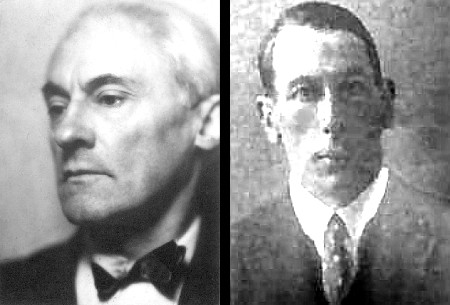
Louis Süe (c. 1912) and André Mare (1937), Wikipedia
together as interior designers to create a variety of furniture and artwork during the Art Deco period of the 1920s. "Individually, both Sue and Mare held great provenance in the decorative arts world, but together, their partnership was quite important producing a very distinctive and much admired style, and they were among the most important designers of the Art Deco movement." ("Sue et Mare", Primavera Gallery website, gathered 8-26-24)
Louis Süe started his professional education at the Sainte-Barbe college in Paris in preparation for going to the engineering school École Polytechnique. He dropped out to enroll at the École des beaux-arts de Paris where he studied under architect Victor Laloux in 1893. Graduating in 1901 as a government certified architect, his work appeared in the Salon des Indépendants and the Salon d'Automne in 1902. Süe began designing buildings in Paris in 1903 in locations such as Rue Cassini, Boulevard Raspail and Boulevard du Montparnasse. He opened an agency with fellow architect Paul Huillard in 1906. In addition to building design, he decorated the house of fashion designer Paul Poiret in the decade that followed where Poiret held his fashion shows. In 1910 Süe went to Vienna with Paul Poiret to visit the Wiener Werkstätte. He was exposed to Cubism around this time which resulted in his incorporating a cubist-inspired style in his work.
André Mare was raised in a rigid atmosphere
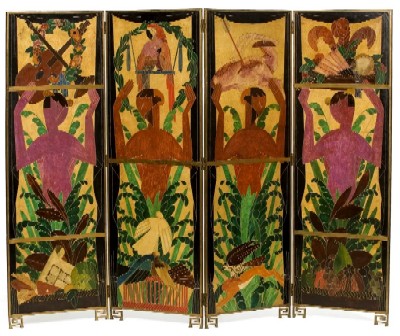
André Mare, Screen with Fauns, Lacquered Paint on Parchment Glued
to Wood, c. 1920, Musee des Arts Decoratifs
where his parents pushed him to study to become a judge. Mare was more interested in the arts, particularly drawing. He decided to study art in Paris at l'École des arts décoratifs (the School of Decorative Arts), also taking courses at l'Académie Julian. He began exhibiting his work at Salon des Independents and the Salon d'Automne in 1906. Like Süe, he began to adopt Cubist styles in his art. By 1910, his interest in the decorative arts led him to design furniture and other decorative items. Working with artistic colleagues from the collective Section d'Or and Raymond Duchamp-Villon, he presented La Maison cubiste [the Cubist House] at the Salon d'Automne in 1912. This established him as a decorator.
Süe started his own interior design workshop L'Atelier Francaise (French Workshop] in 1912. The members included Süe, Roger de La Fresnaye, André Groult, Gustave Louis Jaulmes, and André and Paul Vera. "André Vera wrote a manifesto that defined the goal of the group as combining traditional and modern ideas to bring clarity, order and aesthetic unity to interior design. Süe helped decorate Groult's house." ("Louis Süe", Wikipedia, gathered 5-14-25) They designed and created furniture, textiles and ceramics. Süe also designed perfume bottles for fashion designer Jean Patou. Süe became associated with Mare in 1914, but the Atelier was dissolved soon after when World War I began.
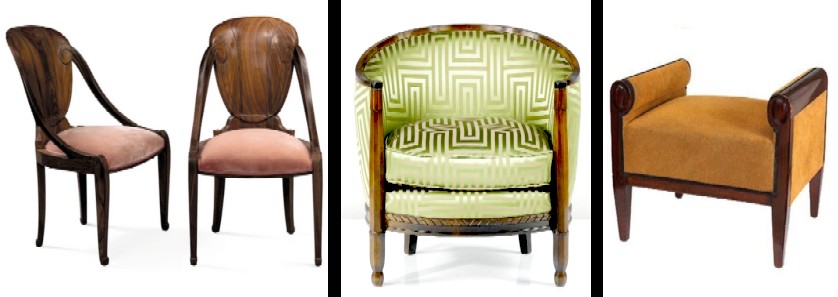
Chairs by Louis Süe and André Mare from left - Armchairs, Mahogany and Velvet, Designed for David Weill, c. 1923, Sotheby's; Armchair, Mahogany and Fabric, Sold at Sotheby's in 2014, 1928, Pinterest; Stool with Arms, Mahogany and Fabric, 1920s, 1st Dibs
Both Süe and Mare were called into military service following the general mobilization decree of August 1, 1914. Süe served with the Army in southern Greece. Mare started in the 3rd French Artillery regiment in Belgium. He was assigned to the 13th Artillery in 1915 where the camouflage design group were attached. He had himself assigned to them, helping to develop military camouflage for the French, British and Italian armies in cooperation with other artists using his Cubist designs.
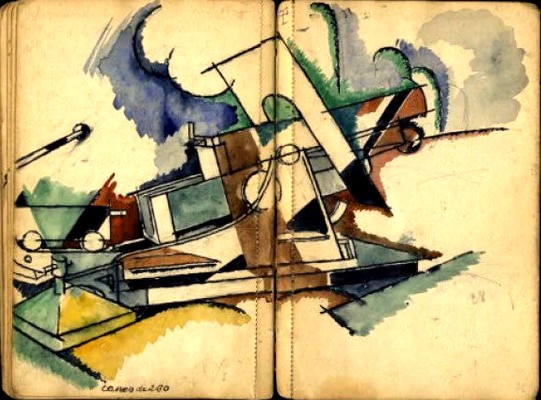
Camouflage Pattern by Mare, From Le canon de 280 camouflé, carnet de guerre no. 2, 1915, Wikimedia
[Mare] was the first to apply Cubist theories to the art of war. The art of camouflage may date back to the earliest days of human civilization, but the first time it was ever officially and systematically used during wartime was in World War I. As a French army soldier, Mare was one of the first people drafted into a camouflage unit. He applied his talents broadly and successfully, leading his team in the development of a number of innovative techniques. He designed realistic looking fake trees, hollow on the inside so soldiers could climb up inside of them and use them as lookouts; he painted tanks, artillery, and the outside of tents to render them invisible from the air; and he designed and built false targets. We know about all of his ideas today because the whole time he was fighting, Mare kept a detailed diary of his experiences. Its pages show detailed, color drawings explaining how he used Cubist techniques to reduce objects in space to shapes, colors and planes in order to fool the eyes of German pilots. Just as with a Cubist painting, which strives to capture four-dimensional reality, Mare created trompe l'oeil worlds on the battlefield that captured a multitude of different perspectives all at once, so that even whilst moving, viewers could not be sure exactly what was passing before their eyes. (Phillip Barcio, "André Mare - Camouflaging the War", Ideel Art website, gathered 5-14-25)
Süe and Mare joined forces in 1919 with the creation of
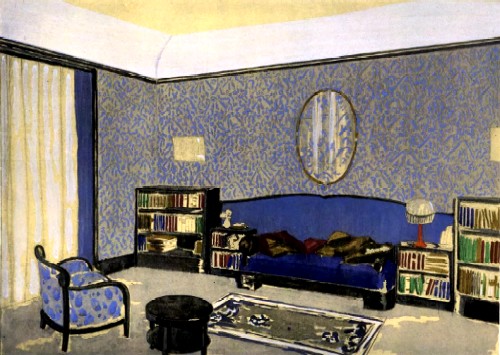
Design for a Studio, From Interieurs 1, Published by Leon Moussinac, 1924, Plate 46
Compagnie des arts français (French Arts Company) which attracted painters and sculptors with an interest in the decorative applications of their work. Among the artists involved in the Compagnie were Paul Véra, Gustave-Louis Jaulmes, Richard Desvallières, Charles Dufresne, André Duwalnut de Segonzac, Bernard Boutet de Monvel, Jean-Louis Boussingault, André Marty, Pierre Poisson and Maurice Marinot. They published images of their concepts for furniture, wallpaper, tapestry, silverware and ceramics design in their manifesto Architectures in 1921, aiming to provide interior designs for sophisticated and wealthy clients. The company also produced furnishings and decorative objects as the images below attest.
For the touchstone 1925 Exposition internationale des Arts décoratifs et industriels modernes, the company created the 'Museum of Contemporary Art' pavilion, the 'Fontaine' pavilion and decorated the function room of the Grand Palais as well as the Parfum d'Orsay's perfume display. This gave Compagnie des arts français a great deal of international exposure and recognition.
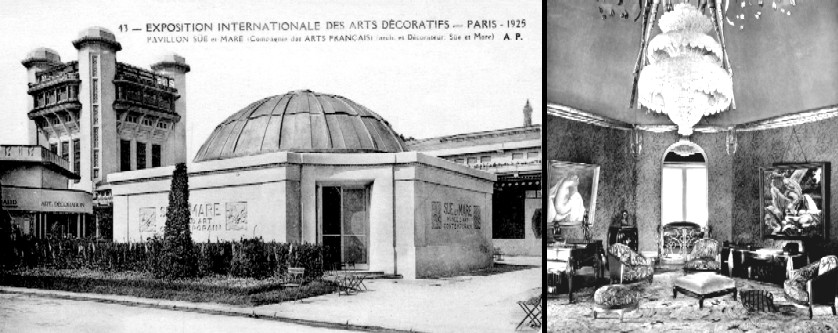
Louis Süe and André Mare at the Exposition Internationale des Arts Decoratifs, Paris, 1925, from left - Sue et Mare Pavillion at the Exposition, Postcard, Ebay; Grand Salon by Sue and Mare, From Ensembles Mobiliers by Maurice Dufrene, 1925, 28, Plate NYPL Digital Collection
Louis Süe brought multiple projects to the Compagnie including prestigious construction and decoration commissions from 1921 to 1927.
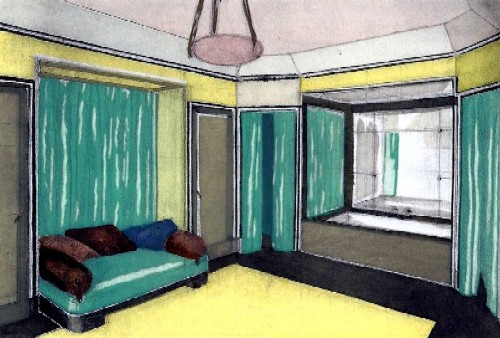
Banquet for Jean Patou's Salon, Interieurs Francais, Jean Badovici editor, 1925, Plate XXXIII
These included designing and furnishing the French Embassy in Washington, the Polish Embassy in Paris, the shops of the jeweler Robert Linzeler and perfumer Jean Patou as well as the luxury cabins for the ocean liner Paris and the first-class drawing room on the liner Ile-de-France. (For a more complete listing of their clients, see the architecture and decorating projects listed on this page for the years 1919 - 1927)
Süe and Mare's partnership ended when Mare stepped down as technical director of the Compagnie for health reasons in 1927. He then ceased to create furniture and accessories to refocused on painting. Süe's involvement with the company did not last long after Mare left. In 1922 the Company was given financial support by Gaston Monteux, owner of the Raoul shoe firm. When it started struggling financially in the late 1920s, Monteaux sold it to the owners of the French department store Galeries Lafayette, who wanted to add a prestigious subsidiary to the department store's decorative arts workshops. Jacques Adnet was appointed as the artistic director. (See this page for more on Adnet's work with the company.)
After the company was sold, Süe continued to work independently in architecture and interior design. He focused his attention on particular projects

Octagonal Dining Room byy Louis Süe for Bernard Boutet de Monvel,
Mirrored Doors and Table Top, Wrought Iron Table Frame, 1927,
Harper's Bazaar, July, 1927, p. 66
rather than mass production. These included a villa for Jean Patou built between 1929 and 1931 and the conversion of the Hotel Hesselin in Paris into a mansion for Helena Rubinstein from 1934-37. He built the French Village for the 1939 New York World's Fair. He moved to Istanbul during World War II where he taught at the Institute of Fine Arts. After the war, he returned to architecture and interior design in France. Mare continued to paint until his death from tuberculosis in 1932.
Critic Jean Badovici said that the result of their work together was "an admirable association of two dissimilar minds, which combined the best of their qualities to put them at the service of Beauty. One provides a sure and precise knowledge of a rigorous sense of geometry; the other a refined and delicate sensibility." ("Sue et Mare", gathered 8-26-24)
Although they both embraced the geometric forms derived from Cubism in their work, their style as a team tended to be more ornate than Modernist and somewhat decorative, recalling the designs of the past while at the same time simplifying them. Léon Moussinac quoted them as saying, "Some modern interiors are designed in such a way that it is impossible to hang there, without discord, an 18th century engraving in its old frame. On the contrary, we would like any beautiful piece of furniture from the past to be at home, among our furniture, to be received there like an ancestor and not like an intruder." (Moussinac, "Introduction", Interieurs I, 1924) Their designs "featured flair such as sculpted floral and fruit motifs, scalloped edges, and inlays of ivory and mother of pearl." ("Süe et Mare", Miason Gerard website, gathered 8-26-24) After the pair broke up, however, some of the pieces Louis Süe produced did embrace the modernist style as the images below indicate.
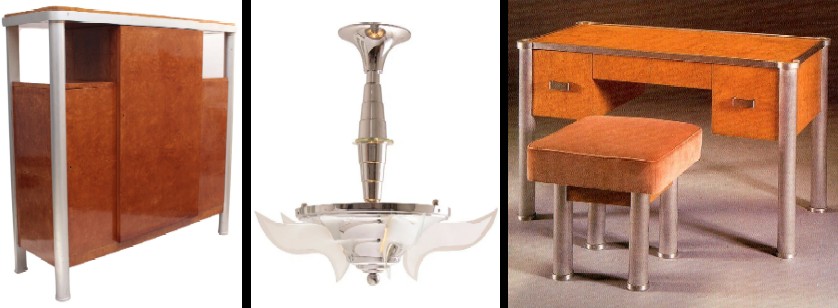
Modernist Furniture by Louis Süe, from left - Chandelier, Chromed Metal, Frosted Glass, c. 1930, The Old Cinema; Armoire, Burl Elm or Amboyna with Lacquered Aluminum Posts and Trim, c. 1934, 1st Dibs; Dressing Table with Stool, Ash and Enameled Aluminum, 1933, Ebay
Sources Not Cited Above:
"Sue et Mare", Incollect website, gathered 8-26-24
"André Mare Furniture", 1st Dibs website, gathered 8-26-24
"André Mare", French Wikipedia, gathered 8-26-24
"Louis Süe", French Wikipedia, gathered 8-26-24
"1925 art deco Clock - Sue et Mare", 1930.Fr website, gathered 8-26-24
"The Compagnie des Arts Français", Musée des Arts Décoratifs website, gathered 8-26-24
Original Facebook Group Posting
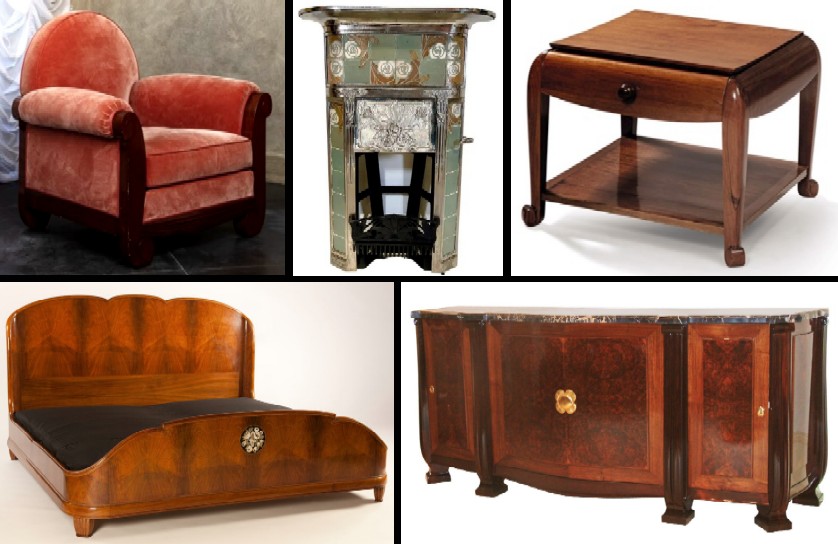
Louis Süe and André Mare Furniture Examples, from left - Armchair, Mahogany and Velvet, c1920, Sotheby's; Fireplace with Stylized Roses, Ceramic and Iron, Gentil-Bourdet ceramiste Billancourt Paris, 1920s, 1st Dibs; Occasional Table, Brazilian Rosewood, c. 1920s, Artnet; Sue et Mare, Bed, Rosewood and Walnut with Inlay, c. 1920-5, Heritage Auctions; Cabinet, Black Rosewood and Burl Walnut, with Gilt Bronze Fittings and Marble Top. c. 1925, 1st Dibs;